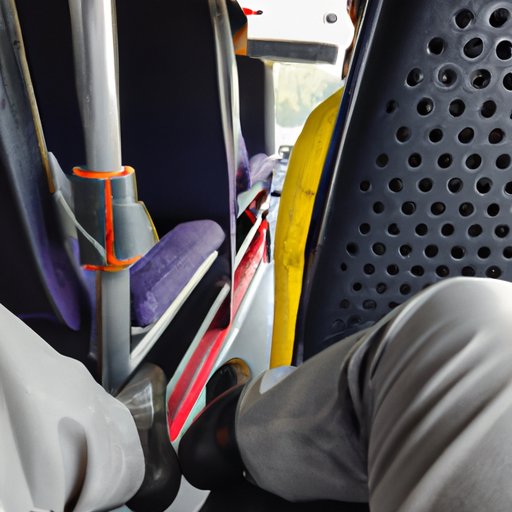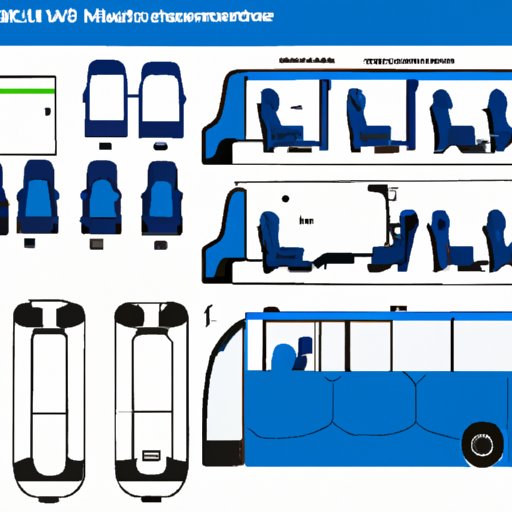Introduction
When it comes to transportation, one of the most important factors to consider is the number of passengers that can safely fit on the vehicle. This is especially true when it comes to buses, which are often used to transport large groups of people such as school children or tourists. Knowing how many people can fit on a bus is essential for ensuring the safety and comfort of all passengers.
In this article, we’ll explore the various factors that influence how many people can fit on a bus, as well as strategies for maximizing passenger capacity. We’ll also look at the pros and cons of having a higher capacity and provide a comprehensive guide to calculating total passenger capacity.
How Many People Can Fit on a Bus: A Guide to Passenger Capacity
Before we can determine how many people can fit on a bus, it’s important to understand the various factors that influence passenger capacity. These include the type of bus, seating configuration, and safety regulations. Let’s take a closer look at each of these.
Factors that Influence Passenger Capacity
The type of bus you’re using will have an impact on how many people can fit on it. Different types of buses can accommodate different numbers of passengers, depending on their size and design. For example, a double-decker bus will typically be able to hold more passengers than a single-decker bus.
Seating configurations also play an important role in determining passenger capacity. If the seats are arranged in a traditional manner with rows and columns, then there will be less space for passengers. However, if the seats are arranged in a more open configuration, then more passengers can be accommodated.
Finally, safety regulations will also affect how many people can fit on a bus. Most countries have laws and regulations that specify the maximum number of passengers that can be safely transported on a bus. It’s important to adhere to these regulations to ensure the safety of all passengers.
Different Types of Buses and Their Capacity
Now that we’ve explored the factors that influence passenger capacity, let’s take a look at the different types of buses and their capacity. The following table provides an overview of the most common types of buses and their estimated capacity.
| Type of Bus | Estimated Capacity |
|---|---|
| Single-decker bus | 50-60 passengers |
| Double-decker bus | 100-120 passengers |
| Mini-bus | 15-25 passengers |
| Coach bus | 35-55 passengers |
It’s important to note that these estimates may vary depending on the manufacturer. Additionally, the seating configuration and other factors such as luggage can also affect the total capacity of a bus.
Calculating Total Passenger Capacity
Once you’ve determined the type of bus you’ll be using, you can then calculate the total passenger capacity. To do this, you’ll need to take into account the number of seats, the space between them, and any additional space needed for wheelchairs, luggage, etc. You should also factor in any safety regulations that may limit the total number of passengers.
Once you’ve calculated the total passenger capacity of your bus, you can then use this information to determine the optimal seating configuration. This will help you maximize the number of passengers you can accommodate while still ensuring everyone’s safety and comfort.
The Ultimate Guide to Maximizing Bus Passenger Capacity
When it comes to maximizing bus passenger capacity, there are several strategies you can use. One of the most effective ways is to use seating configurations that maximize the number of passengers while still providing enough room for everyone to be comfortable. Here are some tips for doing this:
- Arrange seats in rows and columns to make the most efficient use of space.
- Remove unnecessary seats to make room for more passengers.
- Utilize fold-down seats or benches to increase capacity.
- Allow standing passengers, if allowed by safety regulations.
By using these strategies, you can maximize the number of passengers that can fit on a bus without compromising safety or comfort.
A Comprehensive Look at Bus Passenger Capacity
When it comes to bus passenger capacity, it’s important to understand the pros and cons of having a higher capacity. On the one hand, having a higher capacity allows you to transport more people, which can be beneficial if you’re transporting a large group of people. On the other hand, having a higher capacity can also lead to overcrowding and other safety issues.
It’s also important to understand safety regulations related to bus passenger capacity. These regulations exist to ensure the safety of all passengers and must be adhered to at all times. If the regulations are not followed, then it could result in serious consequences for the driver and passengers.

Understanding Bus Passenger Capacity: What You Need To Know
When it comes to understanding bus passenger capacity, one of the most important things to consider is the size of the bus. Different sizes of buses can accommodate different numbers of passengers, so it’s important to choose the right size for your needs. It’s also important to compare the cost of different sizes of buses to ensure you get the best value for your money.
Another important factor to consider is the seating configuration. By arranging the seats in an efficient manner, you can maximize the number of passengers that can fit on a bus while still ensuring everyone’s comfort and safety.

Exploring the Pros and Cons of Bus Passenger Capacity
Having a higher bus passenger capacity has both advantages and disadvantages. On the plus side, having a higher capacity allows you to transport more people, which can be beneficial if you’re transporting a large group of people. However, having a higher capacity can also lead to overcrowding and other safety issues.
It’s important to weigh the pros and cons carefully before deciding on the ideal bus passenger capacity for your needs. By considering all the factors involved, you can make sure that you’re making the best decision for your situation.
Calculating Bus Passenger Capacity: How Many Can Fit?
Once you’ve decided on the ideal bus passenger capacity for your needs, you can then estimate the number of people who can be safely accommodated. To do this, you’ll need to take into account the total capacity of the bus, the seating configuration, and any safety regulations that may apply. This will help you determine the exact number of passengers that can fit on the bus.
You should also calculate the weight limit of the bus. This will help you ensure that the bus is not overloaded, which can cause serious safety issues. Most buses have a weight limit of around 10,000 lbs, but this may vary depending on the type of bus.

Balancing Safety and Comfort with Bus Passenger Capacity
It’s important to balance safety and comfort when it comes to bus passenger capacity. You want to make sure that all safety regulations are met, while also making sure that passengers are comfortable. To achieve this, you should make sure that the seating configuration is efficient and that there is enough room for everyone.
You should also make sure that the bus is not overloaded. Overloading the bus can lead to serious safety issues and should be avoided at all costs. By following these guidelines, you can ensure that all passengers are safe and comfortable while traveling on the bus.
Conclusion
In conclusion, understanding how many people can fit on a bus is essential for ensuring the safety and comfort of all passengers. Factors such as the type of bus, seating configuration, and safety regulations all play an important role in determining passenger capacity. Additionally, there are several strategies for maximizing bus passenger capacity, such as using efficient seating configurations and allowing standing passengers. Finally, it’s important to consider the pros and cons of having a higher capacity, as well as the cost of different sizes of buses.
By taking these factors into consideration, you can determine the ideal bus passenger capacity for your needs and ensure the safety and comfort of all passengers.
(Note: Is this article not meeting your expectations? Do you have knowledge or insights to share? Unlock new opportunities and expand your reach by joining our authors team. Click Registration to join us and share your expertise with our readers.)
